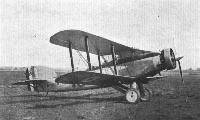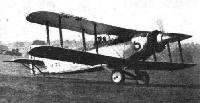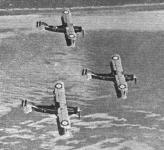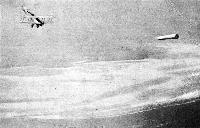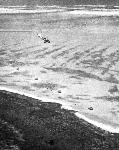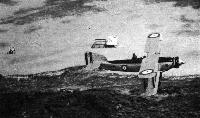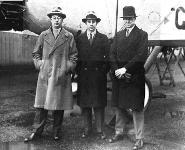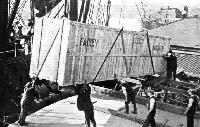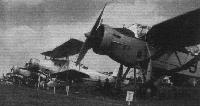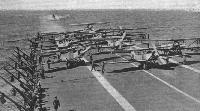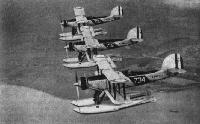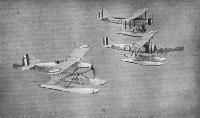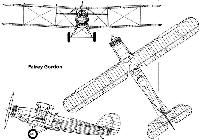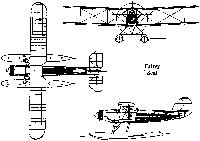
Описание
Страна : Великобритания
Год : 1931
Двухместный дневной бомбардировщик/многоцелевой самолет
Варианты
- Fairey - Fairey III - 1917 - Великобритания
- Fairey - Fairey IIIF - 1926 - Великобритания
- Fairey - Gordon / Seal - 1931 - Великобритания
Gordon / Seal
Корабельный (палубный или катапультный) разведчик. Одномоторный цельнометаллический биплан. Шасси сменное: колеса или два поплавка.
Создан в КБ фирмы "Фэйри авиэйшн". Являлся морским аналогом сухопутного разведчика "Гордон" II и отличался от него хвостовым колесом вместо костыля, тормозными колесами и катапультным оборудованием. И "Сил", и "Гордон" представляли собой дальнейшее развитие самолета Фэйри IIIF. "Гордон" первоначально именовался IIIF Mk.V, a "Сил" - IIIF Mk.VI. Первый опытный экземпляр "Сила", переделанный из IIIF Mk.IIIB, поднялся в воздух 27 ноября 1931 г. (на колесах); на поплавках первый полет состоялся 23 сентября 1932 г.
Серийное производство "Сила" начали в 1 933 г. на заводе "Фэйри" в Хэйсе. Всего изготовили 104 экз.
Разведчики "Сил" состояли на вооружении британского флота с апреля 1933 г., а также в Перу, Аргентине и Чили - с 1934 г., в Латвии - с 1935 г.
Экипаж - 3 чел. Двигатель "Пантер" IIA - на большинстве самолетов, "Пантер" VI - на экспортных машинах для Аргентины, "Лайон" XI - для Чили, "Пегасус" IIIM3 - для Латвии. Вооружение 2x7,69, бомбы до 230 кг.
С весны 1933 г. самолеты "Сил" начали эксплуатироваться на авианосцах британского флота - "Корейджес", "Гермес", "Игл", "Фьюриэс" и "Глориэс". Машины, установленные на поплавки, летали в основном с береговых баз. С 1938 г. "силы" на авианосцах заменяются на более современные бипланы типов "Шарк" и "Свордфиш". К началу Второй мировой войны поплавковые разведчики сохранились на базах в колониях, в частности, на Цейлоне, где осуществляли противолодочное патрулирование у побережья. Большая часть из них была уничтожена в апреле 1942 г. при ударе соединения адмирала Нагумо по Коломбо и Тринкомали, остальные вскоре списали.
Латвийские гидросамолеты в состав ВВС РККА в 1940 г. не вошли, их использовали как мишени на полигоне.
"Сил" сняли с производства в марте 1935 г.
На поплавки ставили и сухопутные разведчики "Гордон", эксплуатировавшиеся в колониях, в частности - в Египте. Первые из них на поплавки от IIIF поставили в начале 1933 г. Пять "гордонов" на поплавках в 1934 г. продали в Бразилию. Поплавковые "гордоны" служили до 1938 г, а их колесные собратья в учебных подразделениях - до сентября 1941 г.
"Сил"||
Размах:||13,94 м
Длина:||10,67 м
Моторы, количество х мощность:||1х 525 л. с.
Взлетная масса, максимальная:||2720 кг
Максимальная скорость:||207 км/ч
Практический потолок:||4230 м
Дальность:||650 км
Описание:
- Gordon / Seal
- Fairey Gordon и Seal
- Flight, June 1931
SPECIAL TYPES AT THE DISPLAY - Flight, November 1932
British Aircraft
Фотографии
-
Flight 1931-06 / Flight
Регистрационный номер: J9154 [3] AIRCRAFT TYPES TO BE SEEN IN THE "EAGLE": 5, The Fairey III F, with Armstrong Siddeley "Panther" engine.
-
Flight 1929-07 / Flight
Регистрационный номер: J9154 [3] FAIREY III F GENERAL PURPOSE (A.S. "Jaguar")
-
Flight 1930-11 / Flight
Регистрационный номер: J9154 [3] THE FAIREY "GORDON": A two-seater day bomber with Armstrong-Siddeley Panther engine.
-
Aeroplane Monthly 1989-02 / Personal album. Military
Регистрационный номер: J9787 J9787 began life as a Fairey IIIF Mk IV in 1929 and was originally assigned to No 35 Squadron. In July 1934 it was converted to Gordon and it is seen here at Catfoss in 1938. The vertical stripes on the fuselage are shadows formed by the wing struts. In June 1939 J9787 became an instructional airframe, 1534M.
-
Flight 1933-10 / Flight
Регистрационный номер: K1167 CHANGING FORMATION: No. 207 Squadron changing from Squadron Formation to Echelon of Flights.
-
Aeroplane Monthly 1990-02 / Personal album. Military
Регистрационный номер: K1730 [2], K2604, K2609, K2610 Another view of 6 Squadron Gordons over Ismailia in the same year. The four nearest aircraft are K1730, K2609, K2610 and K2604. K1730 was struck off RAF charge in July 1936, K2609 was struck off in August 1942, K2610 became an instructional airframe in 1938 and K2604 crashed on take-off at Amman in May 1937.
-
Aeroplane Monthly 1999-12 / C.Cruddas - Airship to India: Dream & disaster /Civilian trailblazing/
Регистрационный номер: K1730 [2] Fairey Gordon K1730 and Bristol F2.B FR4744 of 6 Sqn at Ismailia, Egypt, in the early 1930s, with the redundant airship mooring mast in the distance.
Другие самолёты на фотографии: Bristol F.2A/F.2B Fighter - Великобритания - 1916
-
Aeroplane Monthly 1994-03 / P.Jarrett - Fairey IIIF (1)
Регистрационный номер: K1731 Identified by its fuselage stencilling as a “IIIF Mk V”, K1731 was an early Gordon I used for the A&AEE type trials. The “5” on its nose was its identifying number at a Hendon RAF Display.
-
Aeroplane Monthly 1988-02 / K.Desmond - Richard Fairey 1887-1956 (2)
Регистрационный номер: K1736 Sqd. Ldr. Malcolm Taylor, A.F.C., O.C. No. 40 (Bomber) Squadron, in his Fairey "Gordon" with Armstrong-Siddeley "Panther" engine.
The Gordon was a development of the long-lived Fairey III series fitted with a 575 h.p. Armstrong Siddeley Panther IIA 14-cylinder two-row radial. -
Flight 1932-05 / Flight
Регистрационный номер: K1743 Line up of the 12 "Gordons" of No. 40 (Bomber) Squadron at Upper Heyford.
-
Flight 1933-10 / Flight
Регистрационный номер: K1756 READY FOR THE DAY'S WORK: Fairey "Gordons" ("Panther" engines) lined up on the aerodrome at Bircham Newton.
-
Flight 1935-08 / Flight
Регистрационный номер: K1757 Fairey "Gordons" flying over a remarkably solid-looking "cotton-wool carpet" while on a raid during the Air Exercises.
-
Aeroplane Monthly 1979-03 / F.Adkin - Memoirs of Aircraftsman (3)
Регистрационный номер: K1776 The Fairey "Gordon" is fitted with the 525 h.p. "Panther IIA"
Fairey Gordon K1776 of No 35 (Bomber) Squadron, RAF Worthy Down, This was the unit in which the author served. Note the bomb shackles, flare brackets and leading edge slats. -
Aeroplane Monthly 1990-02 / Personal album. Military
Регистрационный номер: K2607 Fairey Gordon I K2607 of 6 Sqn was based at Ismailia and is seen here in 1934. On February 3, 1939 the aircraft lost control while flying in cloud and crashed near Jerusalem. No 6 Squadron received its Gordons in June 1931, replacing its aged Bristol F.2Bs, and the type remained in service with the unit until replaced by Hawker Harts in October 1935.
-
Air Pictorial 1955-11 / B.Robertson - British military serials - their origin and history (1)
Регистрационный номер: KR2641 A Fairey Gordon of No. 47 Squadron showing the "R" for Re-built.
-
Air Pictorial 1977-12 / J.Hunt - Aviation in the Sudan - before independence
Регистрационный номер: K2645 Легкий бомбардировщик Fairey Gordon Mk I из 47-й эскадрильи Заморских сил Его Величества над Кассалой, Судан, 1935 год.
Between the wars the main R.A.F. unit based in the Sudan was No. 47 Squadron. Here one of No. 47's Fairey Gordons, K2645, piloted by F/O. J. B. T. Whitehead, is seen flying past Jebel Kassala in 1933 -
Aeroplane Monthly 1994-03 / P.Jarrett - Fairey IIIF (1)
Регистрационный номер: K2686 Fairey Gordon I K2686 of 35 Sqn, photographed while flying past ground targets at North Coates Fitties in June 1933. The rear gunner is firing at target No 4.
-
Aeroplane Monthly 1979-03 / F.Adkin - Memoirs of Aircraftsman (3)
Регистрационный номер: K2689 [2] More 35 Squadron Gordons, with K2689 nearest, bombed up and with a camera gun on the rear cockpit mounting.
-
Aeroplane Monthly 1979-03 / F.Adkin - Memoirs of Aircraftsman (3)
Регистрационный номер: K2689 [2] Another shot of K2689 and friends in formation; "a three-dimensional aerial ballet."
-
Flight 1933-10 / Flight
Регистрационный номер: K2691 [2] IN SQUADRON FORMATION: Fairey "Gordons" of No. 207 (Bomber) Squadron.
-
Aeroplane Monthly 1979-03
Регистрационный номер: K2691 [2] Another Flight photograph, this time featuring the Fairey Gordons Is of 207(B) Squadron, RAF, up from Bircham Newton in June 1933.
-
Aeroplane Monthly 1986-05 / Personal album
Регистрационный номер: K2717 Fairey Gordon I K2717. It was delivered to the RAF in 1932 and first flew with 1 Air Armament School (AAS) before passing to 1 Armament Training Station (ATS). On August .5, 1939, K2717 was transferred to the Royal New Zealand Air Force. A total of 271 Gordons was built, including a number of converted Fairey IIIFs, from which the type derived.
-
Aeroplane Monthly 1981-09 / T.Dudgeon - The Habbaniya campaign (1)
Регистрационный номер: K2743 Fairey Gordon I K2743, at Fayid in Egypt on April 22, 1943, had served earlier in Iraq
-
Aeroplane Monthly 1981-10 / T.Dudgeon - The Habbaniya campaign (2)
Регистрационный номер: K3994 Ten years after being introduced, into RAF service, Fairy Gordons were still plodding around the Middle East. The example here, K3994, is seen at Fayid, Egypt, on May 12, 1943.
-
Flight 1936-06 / Flight
The Fairey Gordon, also a G.P. type, with the 535 h.p. Siddeley Panther IIa.
-
Air Pictorial 1977-07 / M.Bowyer - R.A.F. on Parade - the 1935 Jubilee Review
A Fairey Gordon of No. 35 Squadron in the Review line-up
-
Flight 1932-06 / Flight
ANOTHER NEW AIRCRAFT TYPE WHICH WILL BE SEEN AT THE DISPLAY AT HENDON ON JUNE 25: The Fairey Night Bomber (two Rolls-Royce "Kestrel" engines) is the only monoplane among the new machines of this class. It has a wing span of more than 100 ft., and the gross weight is 19,050 lb.
Другие самолёты на фотографии: Fairey Hendon - Великобритания - 1930
-
Aeroplane Monthly 1990-03 / W.Smith - The Flying Shuftis
Регистрационный номер: KR1729 [2] An impressive line-up of 208 Squadron Audaxes, Fairey Gordons and Vickers Valentias at RAF Heliopolis in early 1939. Atlases had been phased out of service with 208 Squadron by the end of 1935, superseded by the Audax.
Другие самолёты на фотографии: Hawker Audax - Великобритания - 1931Vickers Valentia - Великобритания - 1934
-
Air-Britain Aeromilitaria 1980-03
Регистрационный номер: KR1729 [2] R.A.F. bomber squadrons are stationed abroad. Here is a striking “pose” by the machines and personnel of the R.A.F. station at Heliopolis. This picture was taken last year, before re-equipment.
Другие самолёты на фотографии: Hawker Audax - Великобритания - 1931Vickers Valentia - Великобритания - 1934
-
Aeroplane Monthly 1985-07 / P.Lamboit - Eyes in the sky (2)
An airman passes an aerial camera up to the crewman of a 40 Sqn Fairey Gordon at Upper Heyford in 1932.
-
Flight 1932-05 / Flight
Handing up a camera to the observer.
-
Flight 1934-06 / Flight
"Gordon" ("Panther") day bombers of No. 35 (Bomber) Squadron.
-
Flight 1934-10 / Flight
SQUADRON "V": Fairey "Gordons" with Siddeley "Panther" engines flown by No. 40 (Bomber) Squadron.
-
Aeroplane Monthly 1990-02 / Personal album. Military
A flight of 6 Sqn Fairey Gordons over Ismailia in 1934.
-
Flight 1932-05 / Flight
Squadron "V": A fine piece of formation flying by No. 40 (Bomber) Squadron.
-
Flight 1932-05 / Flight
Line Abreast: Among the clouds on a stormy day.
-
Flight 1933-09 / Flight
THE GAY "GORDONS": No. 40 (Bomber) Squadron have just dropped bombs on the three capital ships, H.M.S. Renown, Warspite and Malaya. Destroyers are scurrying in all directions. Observe how the Main Fleet has changed direction to avoid the air attack.
-
Flight 1932-05 / Flight
"Squadron, Right wheel": No. 40 (Bomber) Squadron in squadron formation.
-
Flight 1936-01 / Flight
A SERVICE RECORD: Figures recently issued by the Air Ministry show that the flying time of the machines engaged in the 1935 Air Exercises aggregated 3,839 1/2 hours, which is an increase of 37 per cent, over the figures for 1934. High-altitude fighting was an outstanding feature, combats between light bombers and fighters being fought at about 21,000 ft. This photograph taken during the Exercises, shows such an engagement. The fighters are Furies and the picture was secured from a Gordon.
Другие самолёты на фотографии: Hawker Fury - Великобритания - 1931
-
Flight 1933-12 / Flight
FIRING AT THE DROGUE: When a gunner has proved himself at the ground targets he is allowed to fire at targets in the air, and his merit is rated by his success at this practice.
-
Flight 1933-12 / Flight
GROUND TARGETS: A line of targets for preliminary gunnery practice is laid out along the wet sand, and a "Gordon" is firing at them. Note the shadow of the machine.
-
Flight 1933-12 / Flight
GUNNERY TARGETS: The "Gordon" is flying past the line of ground targets (which are covered with old aeroplane fabric) and the rear gunner is firing at target No. 4.
-
Flight 1936-07 / Flight
A GAY CO-OPERATIVE GORDON: This picture from an Asiatic desert is probably the first of a Fairey Gordon general-purpose machine equipped with a hook for collecting messages from ground forces. The verticals (sometimes formed on actual service by rifles with their bayonets stuck in the ground) seem reluctant to part with the message.
-
Flight 1934-07 / Flight
FOR GUNNERY TRAINING: Three Bristol "Bulldog II.A" ("Jupiter VII.F.P.") of No.29 (Fighter Squadron) and a Fairey "Gordon" ("Panther II.A") start off to give a demonstration aerial target practice. The target is towed by the "Gordon," and the "Bulldogs" swoop down on the former and fire at it with their machine guns.
Другие самолёты на фотографии: Bristol Bulldog - Великобритания - 1927
-
Flight 1932-05 / Flight
Pilots of No. 40 B.S. (left to right): Sgts. Emly, Harris, Pattenden, Sowden, Evans; F/O. D. G. Morris; Flt. Lts. J. E. L. Drabble, C. C. Edwards, R. J. H. Holland; (behind) F/O. N. C. M. Styche; Sqd. Ldr. M. L. Taylor, A.F.C.; (behind) P/O. O. P. E. Williams; F/O. H. V. L'Amy; P/O. A. Taylor; F/O's. H. P. Wilson, G. Calvert; Sgt. Christian; P. O. G. W. Montagu; Sgt. O'Brien; P/O. R. H. Page; Sgt. Avent; F/O. L. F. H. Orr; P/O. W. H. N. Turner.
-
Flight 1932-05 / Flight
The Airmen of No. 40 (Bomber) Squadron.
-
Flight 1933-10 / Flight
Регистрационный номер: J9067 PILOTS OF No. 207 (BOMBER) SQUADRON: From left to right, P Sgt. Mitchell, P/Sgt. Lawton, P O. Terdrey, F O. Bax, Flt. Lt. Ware, Sqd. Ldr. Vachell, Flt. Lt. Crummy, P/Sgt. Gould, and P/Sgt. Goodwin.
-
Aviation Historian 10 / F.Merriam - Birds of a Feather /Echoes from Dawn Skies/ (5)
Регистрационный номер: G-AATT A 1930 photograph of Ronald Kemp (furthest right) beside a Fairey IIIF of the Air Survey Company he established with Frederick Raynham in 1924. Alongside Kemp are two directors of the company: Sqn Ldr Maurice Wright (centre) and Mr A.G. HazelI.
ON this page we show how the Eagle Camera has been arranged in the III F.'s supplied by the Fairey Aviation Co. to the Air Survey Co. for their work in the Sudan. G-AATT, the second of these machines to be taken over, is being flown out to the Sudan by Mr. R. C. Kemp with a mechanic, Mr. A. Calder, as his passenger. Mr. Kemp is, of course, the man to whom the Air Survey Co. owes its being, and he is seen here on the right, with Sqdn.-Ldr. Maurice Wright and Mr. A. G. Hazell, who are now also directors of the company. Mr. Kemp left Croydon at 8-30 a.m. on Sunday, February 9, and arrived at Lyon at 2.30 P.m. the same day. -
Flight 1930-02 / Flight
ELSEWHERE in this issue we refer to the activities of the Air Survey Company and mention that the second Fairey III F. machine, which has been specially built with a Jaguar VI.C. engine, would shortly be ready. This aircraft was recently demonstrated at Northolt and our photographer has caught Mr. C. R. McMullin showing the sort of speed which makes aircraft for commercial use a paying proposition. The Jaguar engine has been very neatly cowled, and in this case certainly does not spoil the proverbially good lines of the III.F.
-
Flight 1932-11 / Flight
The "Gordon" as a Seaplane.
-
Air-Britain Aeromilitaria 1988-04
Регистрационный номер: K1740 Gordon K1740, previously of No.40 Squadron, on floats at Felixstowe during trials. Water handling was better than on the Fairey IIIF. Apart from No.47 Squadron's periodic changes from wheels to floats at Khartoum, five of the twenty Gordons sold to the Brazilian Navy were floatplanes.
-
Моделист-Конструктор Гидросамолеты Второй мировой войны
Поплавковый "Гордон" бразильского флота в полете, 1934 г.
-
Flight 1932-10 / Flight
BRITISH AIRCRAFT FOR SOUTH AMERICA: The last of a batch of Fairey "Gordons" (Armstrong Siddeley "Panther") being embarked and completing an order received from South America.
-
Flight 1934-11 / Flight
The "Seal," Fleet Air Arm three-seater (Siddeley "Panther").
-
Jane's All the World Aircraft 1980 / Encyclopedia of Aviation - Aircraft A-Z - v3
Регистрационный номер: K3481 Fairey Seal.
-
Air-Britain Aeromilitaria 1980-03
Регистрационный номер: K3478 Sister ship to Glorious, Courageous was built as a large cruiser for operations in the Baltic and saw limited action in the North Sea during World War One. With the end of the war, little use could be found for its eccentric design and it was earmarked for conversion to an aircraft carrier on similar lines to Furious which was already in service in this role.
-
Flight 1934-07 / Flight
IN THE LINE: The first machine is the Westland G.P. monoplane. Beyond may be recognised the Fairey G.P. and "Seal" and the Vickers "Vellox."
Другие самолёты на фотографии: Fairey G.4/31 - Великобритания - 1934Vickers Vellore / Vellox - Великобритания - 1928Westland PV.7 - Великобритания - 1933
-
Flight 1934-03 / Flight
FAIREYS AT THE BOTTOM OF THE GARDEN: This photograph, taken on board the aircraft carrier Courageous during the Spring Cruise in the Mediterranean, is of interest not only on account of the large number of Fairey machines ranged on the flying deck, but also because at the back, over the extreme stern, may be seen the Supermarine "Seagull Mark V" with Bristol "Pegasus" engine. The presence of the latest type of amphibian flying boat on board the carrier may be significant.
Другие самолёты на фотографии: Supermarine Walrus/Seagull V - Великобритания - 1933
-
Aviation Historian 39 / A.Tincopa - Wings over Peru
The Seals acquired by Peru were ultimately used both as floatplanes and with wheeled undercarriages. The latter is seen here as a student poses beside a Seal of the Primer Escuadron de Instruccion (First Training Squadron) at San Andres airfield at Pisco on Peru’s southern coast, after a training exercise in November 1940.
-
Aviation Historian 39 / A.Tincopa - Wings over Peru
Seen here fitted with a wheeled undercarriage and wearing the markings of 1 EBO while the latter was still part of III EA, Seal 1-BO-6C (c/n F. 1939) has suffered damage to its rear lower fuselage and is at Las Palmas air base near Lima for repairs. The Peruvian Seals were fitted with supercharged Armstrong Siddeley Panther IIIA engines.
-
Aviation Historian 39 / A.Tincopa - Wings over Peru
A rare photograph of one of the two Seals fitted with dual controls for the training role. This included the fitting of full instrumentation and throttle controls in the rear cockpit. With yet another reallocation in late 1941, the Seals were given serials 28-4-12 to 28-4-16 when they were operated by the 4th Flight of training unit 28 EI.
-
Aviation Historian 39 / A.Tincopa - Wings over Peru
In April 1940 the Seals found a new role when they were reallocated to the Primer Escuadron de Instruccion (I EI - First Training Squadron). Here, students and their instructor from the Escuela de Aviacion Militar pose for a photograph in front of a Seal of I EI in December 1941.
-
Aviation Historian 39 / A.Tincopa - Wings over Peru
CAP students receive instruction on maintenance and overhaul of the Seal’s Panther engine. Note the naval biplane's wings folded rearwards. In total, only 104 Seals were built, 91 of which went to the Fleet Air Arm, with six being sold to Peru, two to Chile, one to Argentina and four to Latvia.
-
Мировая Авиация 125
Возможность замены колесного шасси поплавковым позволяла эксплуатировать Seal с катапульт крупных кораблей.
-
Flight 1935-01 / Flight Advertisements
Регистрационный номер: K3479 [2] A Panther engined Fairey Seal seaplane of the Fleet Arm being placed on its catapult aboard one of HM.'s. battleships.
-
Flight 1937-01 / Flight
A Fairey Seal of the Fleet Air Arm operating as a float plane.
-
Aviation Historian 39 / A.Tincopa - Wings over Peru
Регистрационный номер: K3522 Developed from the Fairey IIIF under Air Ministry Specification 12/29 for a “Spotter Reconnaissance Aeroplane” for the Fleet Air Arm, the prototype Seal (a converted IIIF) made its maiden flight on September 11, 1930, with a wheeled undercarriage; and with floats, as seen here on production example K3522, on September 29, 1932.
-
Моделист-Конструктор Гидросамолеты Второй мировой войны
Регистрационный номер: K3479 [2] Звено разведчиков "Сил" британской морской авиации, 1935 г.
-
Flight 1934-03 / Flight
A FLIGHT OF THE SEAPLANE TRAINING SQUADRON: "Osprey" and "Seal" led by "Tutor."
Другие самолёты на фотографии: Avro Tutor/Sea Tutor/Prefect / Type 621/646/626 - Великобритания - 1929Hawker Osprey - Великобритания - 1930
-
Flight 1935-03 / Flight
ON THEIR LAWFUL OCCASIONS. A magnificent impression of a scene at Gibraltar during the Combined Exercises. The seaplane is a Fairey "Seal" (535 h.p. "Panther IIa") of the Fleet Air Arm. The rain-water catchment slope on the face of the Rock is clearly visible.
-
Flight 1937-12 / Flight
A Fairey Seal spotter reconnaissance floatplane (525 Siddeley Panther IIa) about to start a navigational training flight at Lee-on-the-Solent.
-
Air-Britain Aeromilitaria 1987-01
Регистрационный номер: K3533 Fairey Seal seaplane K3533 of A Flight, Calshot.
-
Flight 1934-03 / Flight
CRAFT OF THE SEAPLANE TRAINING SQUADRON: The machines from left to right are Fairey "Seal," Avro "Tutor," Saro "Cloud," Hawker "Osprey" and Supermarine "Southampton."
Другие самолёты на фотографии: Avro Tutor/Sea Tutor/Prefect / Type 621/646/626 - Великобритания - 1929Hawker Osprey - Великобритания - 1930Saunders-Roe Cloud / A.19 - Великобритания - 1930Supermarine Southampton / Solent - Великобритания - 1925
-
Flight 1935-05 / Flight
A Fairey "Seal" alights across the bows of the photographic pinnace at Felixstowe.
-
Aviation Historian 39 / A.Tincopa - Wings over Peru
This photograph of Cuerpo de Aviacion del Peru (CAP) officers in front of a Fairey Seal floatplane of the Primer Escuadron de Bombardeo y Observation (1 EBO - First Bombardment & Observation Sqn) at the Alferez Carlos Huguet seaplane base at Ancon provides a good impression of the large size of the single-engined biplane.
-
Aviation Historian 39 / A.Tincopa - Wings over Peru
The CAP underwent several reorganisations throughout the 1930s, the Seals of 1 EBO being reallocated in October 1936 from III Escuadron de Aviacion (III EA) to IV EA, with the resulting slight change in (rather long-winded) serial from III/1-BO-1C etc to IV/1-BO-1 C etc. Here, the latter aircraft and four other Seals undergo maintenance at Ancon sometime before the next CAP reorganisation in 1939.
-
Aviation Historian 39 / A.Tincopa - Wings over Peru
After completing a three-year flight course at Las Palmas, fourth-year cadets at the Escuela de Aviacion Militar (Military Aviation School) had to complete a six-month course in seaplane operations at Ancon. Here, an instructor and student cadet return to the seaplane base after completing a training sortie in November 1938.
-
Aviation Historian 39 / A.Tincopa - Wings over Peru
Seal 1-BO-3C during a flight while operating as part of IV EA - note the “IV” above the main serial. Peru was not the only South American nation to acquire the Seal; one (c/n F.2111), fitted with a Panther VI engine, went to the Argentinian government and two were acquired by Chile with Napier Lion XI inline water-cooled engines.
-
Aviation Historian 39 / A.Tincopa - Wings over Peru
The CAP Seals underwent yet another reorganisation in June 1939, when they were allocated to XXXII Escuadron de Informacion Maritima (XXXII EIM), part of Tercer Grupo Aerea (3 GA). The six Seals initially operated with 82 Escuadrilla de Informacion Maritima; this example, fitted with floats, bears the revised serial XXXII-82-6.
-
Air Enthusiast 2003-11 / R.Lezon, R.Stitt - Eyes of the fleet (1)
Fairey Seal 'R-54' at Lago Nahuel Huapi, Bariloche, Provincia de Rio Negro.
-
Air Enthusiast 2003-11 / R.Lezon, R.Stitt - Eyes of the fleet (1)
Fairey IIIF 'R-53', to the right, with its recently-installed Panther VI engine, and identically-powered Fairey Seal 'R-54' at Lago Nahuel Huapi.
Другие самолёты на фотографии: Fairey Fairey IIIF - Великобритания - 1926
-
Авиация и Космонавтика 2018-04 / С.Дроздов - В небе Латвии (1918-2018)
Гидросамолет Фейри «Сиал» английского производства
-
Aeroplane Monthly 1983-12 / L.Coombs - Cockpits of the RAF (3)
The cockpit of a Fairey Gordon in 1937.
-
Aeroplane Monthly 1982-04 / J.Pelly-Fry - The Belle of Berlin
Habbaniya air base. The airfield at the top of the picture was not used at the time. Some of the Harts and Gordons, which can be seen on the polo ground, are on fire.
Другие самолёты на фотографии: Hawker Hart - Великобритания - 1928
-
Aeroplane Monthly 1974-08 / Personal album
Регистрационный номер: K2734 Fairey Gordon I, K2734, strikes oil. This aircraft belonged to No 47 (General Purpose) Squadron, RAF, based at Khartoum, and ended up like this after a night flight in 1937.
-
Aeroplane Monthly 1979-03 / F.Adkin - Memoirs of Aircraftsman (3)
Регистрационный номер: K2761 Gordon K2761 of 35 Squadron "in a bad way" during the unit's earlier days in the Sudan. The aircraft were delivered, crated, to Sealand.
-
Aviation Historian 39 / A.Tincopa - Wings over Peru
... and crunch again! In December 1943 Seal 28-4-15 was involved in a taxying accident when the pilot made a miscalculation and struck a CAP Vultee BT-13 parked next to the runway, causing considerable damage to both aircraft. By late 1944 the Seal had been replaced by more modern American types and, after 11 years of rugged service, the type was retired.
Другие самолёты на фотографии: Vultee BT-13 / SNV Valiant - США - 1939
-
Aeroplane Monthly 1976-07 / Personal album
Регистрационный номер: K2639 Fairey Gordon K2639 crashed after meeting a violent down-draught near Semak in 1934. The Gordon, which replaced the Fairey IIIF, was a two-seat day-bomber and general purpose aircraft. It was powered by the Armstrong Siddeley Panther radial, which gave it a better performance than the Napier Lion powered Fairey IIIF. A total of 160 Gordons were built for the RAF, in addition to a number of reconstructed IIIFs. K2639 was a No 14 Squadron aircraft based at Amman.
-
Aeroplane Monthly 1976-07 / Personal album
Регистрационный номер: K2631 [2] Capt Stead had to force-land this Fairey Gordon, K2631, after an engine failure at night about 50 miles east of Amman on October 12, 1933. As can be seen in photograph, the undercarriage came right back, just missing the pilot, who was unscathed.
-
Aeroplane Monthly 1976-07 / Personal album
Регистрационный номер: K2631 [2] Capt Stead had to force-land this Fairey Gordon, K2631, after an engine failure at night about 50 miles east of Amman on October 12, 1933.
-
Aviation Historian 39 / A.Tincopa - Wings over Peru
Crunch! This unmarked CAP Seal suffered extensive structural damage following a landing accident at Villa auxiliary airfield, near Las Palmas, in September 1940. The Seal was damaged beyond repair and was withdrawn from service.
-
Flight 1934-11 / Flight
"SKYBIRDS". Three recent additions to the realistic 1-72nd-scale models produced by A. J. Holladay & Co., Ltd. They are: Albatros D.III; D.H. "Comet"; and Fairey "Seal."
Другие самолёты на фотографии: Albatros D.III - Германия - 1916De Havilland Comet / D.H.88 - Великобритания - 1934
-
Aeroplane Monthly 1994-05 / O.Thetford - Fairey IIIF and Gordon in service /By day and by night/
Регистрационный номер: K2649 KEITH WOODCOCK’S painting depicts Fairey Gordon K2649 of 207 Sqn, flying from Worthy Down in 1936.
-
Flight 1935-08 / Flight
Attack by a two-seater Hawker "Demon" on a Fairey "Gordon" light bomber. The fighter uses its rear gun from a blind spot under the bomber's nose. The bomber has one fixed front gun, which can only be brought to bear by dipping the nose of the machine. This form of attack can be used by a formation as well as by a single fighter.
Другие самолёты на фотографии: Hawker Demon - Великобритания - 1932
-
Мировая Авиация 125
Fairey Gordon
- Фотографии

